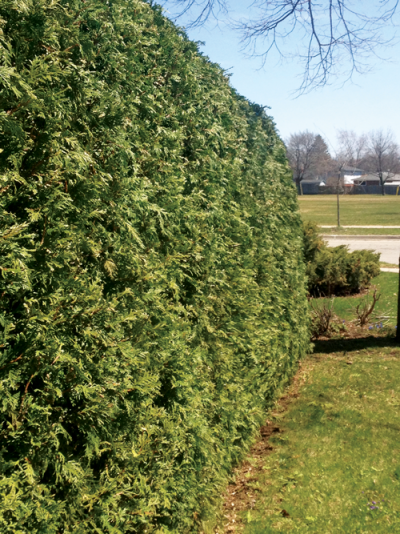June 1, 2014
Green vs. brown: The value of hedges
BY SEAN JAMESThe first concern when most customers ask for a landscape design is, “low maintenance.” I think this may be why hedges have fallen out of favour in the last couple of decades. Perhaps it’s time to reconsider hedges, and start selling them more passionately.
Hedges have many characteristics that make them worth recommending. They can, and should, be longer-lasting than fences if properly maintained. Many municipal bylaws only permit fences six to seven feet tall. Hedges can be trained to be taller, thereby offering more privacy. Another benefit is hedges slow the wind instead of trying to stop it, providing beneficial air circulation. Fences have eddies of wind on the leeward side, whereas hedges simply reduce wind speed.
Living green infrastructure offers many benefits over hardscapes, such as reducing the urban heat-island effect. Just as important however, is that hedges offer increased biodiversity, which means reduced pest populations. A large variety of birds, insects and even mammals will rely on a hedge for shelter and safety. They venture out to feed on and control everything from Japanese beetles to slugs, ultimately reducing maintenance and increasing the aesthetic appeal of our landscapes.

Properly pruned hedges are difficult to find. The sides should be sloped slightly so that the bottom is wider than the top to prevent thinning and allow the sun to reach all parts of the hedge.
Proper maintenance and shaping of hedges is essential, and many people aren’t aware of the details. The sides should be sloped slightly so that the hedge is wider at the bottom than at the top. This allows sunlight to reach all parts of the hedge, which prevents thinning at the bottom. A hedge with a see-through bottom doesn’t offer much privacy. In a perfect world, the top would be slightly peaked to help shed snow.
Frequently, we allow hedges to get an inch or two larger every time we prune them. (Perhaps we feel bad for hurting the hedge, so we leave a bit to compensate?) Once the hedge has reached the desired size, always take it back to exactly where you pruned it to last time. It will get thicker and stronger every time you prune it. Damage from snow and ice is a symptom of not pruning often and tightly enough — not an actual fault with hedging itself.
Some hedges such as yew and privet can be rejuvenated. A yew hedge can be cut back in early spring by as much as a third. This can be done if it has grown out of scale with the landscape. Privet can be cut back by as much as you want, unless there’s a lot of dead wood inside, in which case it should be coppiced right to the ground. It will begin regrowing in about six weeks. Start shaping it when it’s about half the desired width so it forms with good, thick growth.
Informal hedging can be used on larger properties with plants such as bridalwreath spirea and shrub roses. These require next-to-no maintenance, but they do take up a lot more room. They give the same benefits, if not more so (fruit and flowers) than formal hedging.
Hedges can be a beautiful addition to our landscapes. They benefit the environment and they ignore our support. Much of life is about sales. If people are concerned about additional maintenance, remind them that fences need maintenance too, and that hedges never heave or rot.
Now, go make the world greener!
Sean James is owner of an Ontario-based environmentally-conscious landscape design/build/maintenance company, an eco-consultant and a popular speaker.